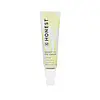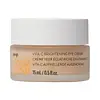What's inside
What's inside
 Key Ingredients
Key Ingredients

 Benefits
Benefits

 Concerns
Concerns

 Ingredients Side-by-side
Ingredients Side-by-side

Water
Skin ConditioningGlycerin
HumectantGlyceryl Stearate Se
EmulsifyingCetearyl Alcohol
EmollientCoco-Caprylate/Caprate
EmollientPropanediol
SolventCetyl Alcohol
EmollientDimethicone
EmollientHelianthus Annuus Seed Oil
EmollientBellis Perennis Flower Extract
Skin ConditioningCoconut Alkanes
EmollientSilica
AbrasiveGlyceryl Stearate Citrate
EmollientSaccharomyces Ferment Filtrate
HumectantHieracium Pilosella Extract
MaskingTetrahexyldecyl Ascorbate
AntioxidantTrisodium Ethylenediamine Disuccinate
1,2-Hexanediol
Skin ConditioningHydroxyacetophenone
AntioxidantSodium Acetylated Hyaluronate
HumectantSodium Hyaluronate
HumectantSclerotium Gum
Emulsion StabilisingXanthan Gum
EmulsifyingButyrospermum Parkii Butter
Skin ConditioningCitric Acid
BufferingTocopherol
AntioxidantSodium Citrate
BufferingCaprylyl Glycol
EmollientSodium Benzoate
MaskingSodium Dehydroacetate
PreservativeCI 77891
Cosmetic ColorantCI 77491
Cosmetic ColorantWater, Glycerin, Glyceryl Stearate Se, Cetearyl Alcohol, Coco-Caprylate/Caprate, Propanediol, Cetyl Alcohol, Dimethicone, Helianthus Annuus Seed Oil, Bellis Perennis Flower Extract, Coconut Alkanes, Silica, Glyceryl Stearate Citrate, Saccharomyces Ferment Filtrate, Hieracium Pilosella Extract, Tetrahexyldecyl Ascorbate, Trisodium Ethylenediamine Disuccinate, 1,2-Hexanediol, Hydroxyacetophenone, Sodium Acetylated Hyaluronate, Sodium Hyaluronate, Sclerotium Gum, Xanthan Gum, Butyrospermum Parkii Butter, Citric Acid, Tocopherol, Sodium Citrate, Caprylyl Glycol, Sodium Benzoate, Sodium Dehydroacetate, CI 77891, CI 77491
Water
Skin ConditioningGlycerin
HumectantHydrogenated Ethylhexyl Olivate
EmollientCoconut Alkanes
EmollientNiacinamide
SmoothingPropanediol
SolventCetyl Alcohol
EmollientMica
Cosmetic ColorantCI 77120
Cosmetic ColorantCetyl Phosphate
EmulsifyingCapryloyl Glycerin/Sebacic Acid Copolymer
Skin ConditioningTetrahexyldecyl Ascorbate
AntioxidantCaffeine
Skin ConditioningSolanum Lycopersicum Fruit/Leaf/Stem Extract
AstringentBidens Pilosa Extract
HumectantAdansonia Digitata Pulp Extract
EmollientTocopherol
AntioxidantSimmondsia Chinensis Seed Oil
EmollientAstrocaryum Murumuru Seed Butter
EmollientGossypium Herbaceum Seed Oil
Skin ConditioningArginine
MaskingHydrogenated Olive Oil Unsaponifiables
EmollientLinum Usitatissimum Seed Oil
PerfumingSqualane
EmollientDiheptyl Succinate
EmollientCitric Acid
BufferingPotassium Sorbate
PreservativeSodium Levulinate
Skin ConditioningCoco-Caprylate/Caprate
EmollientCI 77891
Cosmetic ColorantCI 77491
Cosmetic ColorantGuar Hydroxypropyltrimonium Chloride
Skin ConditioningSodium Benzoate
MaskingSilica
AbrasiveXanthan Gum
EmulsifyingWater, Glycerin, Hydrogenated Ethylhexyl Olivate, Coconut Alkanes, Niacinamide, Propanediol, Cetyl Alcohol, Mica, CI 77120, Cetyl Phosphate, Capryloyl Glycerin/Sebacic Acid Copolymer, Tetrahexyldecyl Ascorbate, Caffeine, Solanum Lycopersicum Fruit/Leaf/Stem Extract, Bidens Pilosa Extract, Adansonia Digitata Pulp Extract, Tocopherol, Simmondsia Chinensis Seed Oil, Astrocaryum Murumuru Seed Butter, Gossypium Herbaceum Seed Oil, Arginine, Hydrogenated Olive Oil Unsaponifiables, Linum Usitatissimum Seed Oil, Squalane, Diheptyl Succinate, Citric Acid, Potassium Sorbate, Sodium Levulinate, Coco-Caprylate/Caprate, CI 77891, CI 77491, Guar Hydroxypropyltrimonium Chloride, Sodium Benzoate, Silica, Xanthan Gum
Ingredients Explained
These ingredients are found in both products.
Ingredients higher up in an ingredient list are typically present in a larger amount.
Cetyl Alcohol is a fatty alcohol. Fatty Alcohols are most often used as an emollient or to thicken a product.
Its main roles are:
Though it has "alcohol" in the name, it is not related to denatured alcohol or ethyl alcohol.
The FDA allows products labeled "alcohol-free" to have fatty alcohols.
Learn more about Cetyl AlcoholCi 77491 is also hydrated iron III oxide. It's sole purpose is to give a red/pink hue to products.
Iron III oxides are classified as inorganic chemicals for coloring.
Synthetically created Ci 77491 is considered safer than those naturally found. This is because the synthetically created version may contain less impurities. Iron oxides are generally non-toxic and non-allergenic.
Learn more about CI 77491Ci 77891 is a white pigment from Titanium dioxide. It is naturally found in minerals such as rutile and ilmenite.
It's main function is to add a white color to cosmetics. It can also be mixed with other colors to create different shades.
Ci 77891 is commonly found in sunscreens due to its ability to block UV rays.
Learn more about CI 77891Citric Acid is an alpha hydroxy acid (AHA) naturally found in citrus fruits like oranges, lemons, and limes.
Like other AHAs, citric acid can exfoliate skin by breaking down the bonds that hold dead skin cells together. This helps reveal smoother and brighter skin underneath.
However, this exfoliating effect only happens at high concentrations (20%) which can be hard to find in cosmetic products.
Due to this, citric acid is usually included in small amounts as a pH adjuster. This helps keep products slightly more acidic and compatible with skin's natural pH.
In skincare formulas, citric acid can:
While it can provide some skin benefits, research shows lactic acid and glycolic acid are generally more effective and less irritating exfoliants.
Most citric acid used in skincare today is made by fermenting sugars (usually from molasses). This synthetic version is identical to the natural citrus form but easier to stabilize and use in formulations.
Read more about some other popular AHA's here:
Learn more about Citric AcidCoco-Caprylate/Caprate is created from fatty coconut alcohol, caprylic acid, and capric acid.
It is a lightweight emollient. Emollients create a thin barrier on the skin to trap moisture in. This helps keep your skin hydrated and soft.
Once applied, Coco-Caprylate/Caprate is absorbed quickly and leaves a silky feel.
Coco-Caprylate/Caprate may not be fungal acne safe.
Learn more about Coco-Caprylate/CaprateCoconut Alkanes is created from the fatty-acids of coconut oil. It is volatile, meaning it evaporates from the skin.
This ingredient is an emollient and solvent. As an emollient, it helps keep skin soft and hydrated. Solvents help distribute and mix other ingredients. This ensures a more even consistency.
Coconut Alkanes may not be fungal-acne safe.
Learn more about Coconut AlkanesGlycerin is already naturally found in your skin. It helps moisturize and protect your skin.
A study from 2016 found glycerin to be more effective as a humectant than AHAs and hyaluronic acid.
As a humectant, it helps the skin stay hydrated by pulling moisture to your skin. The low molecular weight of glycerin allows it to pull moisture into the deeper layers of your skin.
Hydrated skin improves your skin barrier; Your skin barrier helps protect against irritants and bacteria.
Glycerin has also been found to have antimicrobial and antiviral properties. Due to these properties, glycerin is often used in wound and burn treatments.
In cosmetics, glycerin is usually derived from plants such as soybean or palm. However, it can also be sourced from animals, such as tallow or animal fat.
This ingredient is organic, colorless, odorless, and non-toxic.
Glycerin is the name for this ingredient in American English. British English uses Glycerol/Glycerine.
Learn more about GlycerinPropanediol is an all-star ingredient. It softens, hydrates, and smooths the skin.
It’s often used to:
Propanediol is not likely to cause sensitivity and considered safe to use. It is derived from corn or petroleum with a clear color and no scent.
Learn more about PropanediolSilica, also known as silicon dioxide, is a naturally occurring mineral. It is used as a fine, spherical, and porous powder in cosmetics.
Though it has exfoliant properties, the function of silica varies depending on the product.
The unique structure of silica enhances the spreadability and adds smoothness, making it a great texture enhancer.
It is also used as an active carrier, emulsifier, and mattifier due to its ability to absorb excess oil.
In some products, tiny microneedles called spicules are made from silica or hydrolyzed sponge. When you rub them in, they lightly polish away dead skin layers and enhance the penetration of active ingredients.
Learn more about SilicaSodium Benzoate is a preservative. It's used in both cosmetic and food products to inhibit the growth of mold and bacteria. It is typically produced synthetically.
Both the US FDA and EU Health Committee have approved the use of sodium benzoate. In the US, levels of 0.1% (of the total product) are allowed.
Sodium benzoate works as a preservative by inhibiting the growth of bacteria inside of cells. It prevents the cell from fermenting a type of sugar using an enzyme called phosphofructokinase.
It is the salt of benzoic acid. Foods containing sodium benzoate include soda, salad dressings, condiments, fruit juices, wines, and snack foods.
Studies for using ascorbic acid and sodium benzoate in cosmetics are lacking, especially in skincare routines with multiple steps.
We always recommend speaking with a professional, such as a dermatologist, if you have any concerns.
Learn more about Sodium BenzoateTetrahexyldecyl Ascorbate (THD) is a stable and oil-soluble form of Vitamin C.
THD is special in that it has the ability to travel deeper into skin than traditional ascorbic acid while maintaining the same skin benefits (double win!).
Because it’s oil-soluble, THD dives deep into your skin’s fatty layers (think ceramides and cholesterol) to fight off the kind of free radicals that mess with your skin barrier. This makes it a great pair with water-based vitamin C (ascorbic acid) that mainly works on the surface.
Even at just 0.1%, THD is already showing great antioxidant activity. When used up to 2%, it helps keep your skin happy and calm, especially when it’s stressed from pollution or sun.
Want to fade dark spots or tackle hyperpigmentation? You’ll want 5% or more. Pairing it with brightening buddies like niacinamide or licorice root gives even better results. One study even used 30% THD with other brighteners and saw real results on stubborn discoloration, even in melasma-prone skin.
A note on THD: It’s has a slightly silky, oily texture and usually shows up colorless or pale yellow (though the exact shade can vary by supplier).
While you can sneak it into water-based formulas, it really shines when paired with silicones or oils, which help your skin soak it up better.
THD is pretty stable, but it’s still vulnerable to degradation like ascorbic acid. Too much light or heat (above 113°F / 45°C) can break it down over time. Go for dark and opaque packaging that keeps it safe and shady!
Read more about other types of Vitamin C:
Learn more about Tetrahexyldecyl AscorbateTocopherol (also known as Vitamin E) is a common antioxidant used to help protect the skin from free-radicals and strengthen the skin barrier. It's also fat soluble - this means our skin is great at absorbing it.
Vitamin E also helps keep your natural skin lipids healthy. Your lipid skin barrier naturally consists of lipids, ceramides, and fatty acids. Vitamin E offers extra protection for your skin’s lipid barrier, keeping your skin healthy and nourished.
Another benefit is a bit of UV protection. Vitamin E helps reduce the damage caused by UVB rays. (It should not replace your sunscreen). Combining it with Vitamin C can decrease sunburned cells and hyperpigmentation after UV exposure.
You might have noticed Vitamin E + C often paired together. This is because it is great at stabilizing Vitamin C. Using the two together helps increase the effectiveness of both ingredients.
There are often claims that Vitamin E can reduce/prevent scarring, but these claims haven't been confirmed by scientific research.
Learn more about TocopherolWater. It's the most common cosmetic ingredient of all. You'll usually see it at the top of ingredient lists, meaning that it makes up the largest part of the product.
So why is it so popular? Water most often acts as a solvent - this means that it helps dissolve other ingredients into the formulation.
You'll also recognize water as that liquid we all need to stay alive. If you see this, drink a glass of water. Stay hydrated!
Learn more about WaterXanthan gum is used as a stabilizer and thickener within cosmetic products. It helps give products a sticky, thick feeling - preventing them from being too runny.
On the technical side of things, xanthan gum is a polysaccharide - a combination consisting of multiple sugar molecules bonded together.
Xanthan gum is a pretty common and great ingredient. It is a natural, non-toxic, non-irritating ingredient that is also commonly used in food products.
Learn more about Xanthan Gum